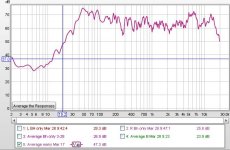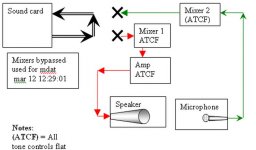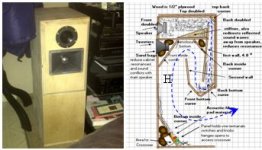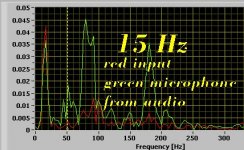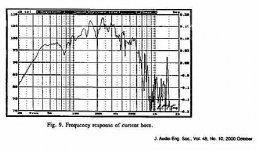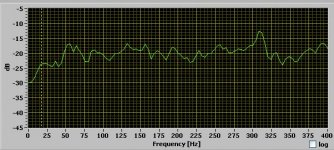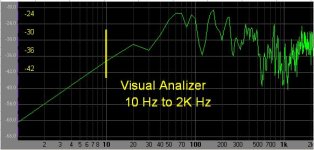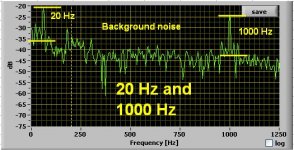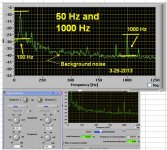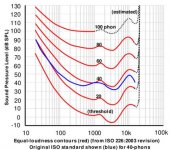I got tired of having a speaker system with 35Hz to 17KHz but no imaging, presence or any of the other 50+ terms I learned working as a CET at a few audio stores.
I decided to build a "good" set of speakers. My wife defines "good" as small (?), goes with the furniture (?), does not cut too deep into the budget (under $100 each), and she can figure out how to use (no knobs, switches, etc).
So it could have no odd shapes, made of stained wood, (she could pick the stain), shorter than a 28" table, and less than a foot wide. Footprint the size of a piece of notebook paper. For cost all the electronics had to be less than $75 and both speakers made from one piece of 3/4" plywood, (she did not require them to be lightweight)
None of this had anything to do with my definition of "good" (impossibly good ?). So I made my list; ultra low distortion less than (2%) THD & IM, a frequency response of 15Hz to 25K Hz. Although my amp is powerful enough, the distortion goes from almost nothing to painful as the volume is turned up, so had to be able to get 85db from only a couple of watts. So throw in efficient.
The only way to get the low distortion and high efficiency was a horn, as it had to be small I designed a 40” ¼ wave folded exponential horn using as much of the box as possible. For added bass used bass doubling by setting them on the floor and rear firing to use doubling with the back wall. The main speaker, to help the SPL is front firing.
The speaker size was already determined. My wife said small or not at all. When she met me I had a pair of 5’ speakers with 12” drivers. They sounded great but…I was replacing a 16” cube subwoofer and two 8 X 6” shoebox speakers. Not counting the 3” stand alone super tweeters this gave me 4, 672 in^3 for two speakers. 24” tall, 12” deep and 8 “ . this left 25 in^3to spare
To have a low distortion, High efficiency, small driver at about $25, I chose the Dayton Audio RS100-8. A horn uses the driver as a piston so the low freq cutoff can be way below the f0 of the driver if it is low mass, long excursion, with a large magnet and phase plug for low simbiance. I wanted a 3” driver as distortion is inversely proportional to size.
I wanted to reduce Doppler distortion and IM as well as have the mid & hi fq SPL match the level of the horn I had to crossover to a horn tweeter. The Pyle PDB78 had the low distortion and 112db Sensitivity required to match the horn, and a price around the $25 target.
The horn simulation software and my own figures showed the bass horn to drop off at about 1000Hz and the tweeter would not come up until 2000 Hz so I decided to use a second order Butterworth to give the extra increase at the crossover freq. Then using the component formulas I split the crossover points 2000 for the main and 1000 for the tweeter. This eliminated the one octave notch. I bought a ready built crossover on eBay that included the binding posts and changed a very few components.
I have been analyzing them for two weeks using REW, VA, Praxis and a few other analyzer software packages. I hardly turn up the volume control for very loud audio ~ 86db. I watch a 10 Hz note coming back from my test microphone. The software programs say less than 1% distortion, and a frequency range of 10Hz to 25K hz, and only 3 weeks of intense math and $100 per speaker pictures and Fq resp screen shots to come.
I decided to build a "good" set of speakers. My wife defines "good" as small (?), goes with the furniture (?), does not cut too deep into the budget (under $100 each), and she can figure out how to use (no knobs, switches, etc).
So it could have no odd shapes, made of stained wood, (she could pick the stain), shorter than a 28" table, and less than a foot wide. Footprint the size of a piece of notebook paper. For cost all the electronics had to be less than $75 and both speakers made from one piece of 3/4" plywood, (she did not require them to be lightweight)
None of this had anything to do with my definition of "good" (impossibly good ?). So I made my list; ultra low distortion less than (2%) THD & IM, a frequency response of 15Hz to 25K Hz. Although my amp is powerful enough, the distortion goes from almost nothing to painful as the volume is turned up, so had to be able to get 85db from only a couple of watts. So throw in efficient.
The only way to get the low distortion and high efficiency was a horn, as it had to be small I designed a 40” ¼ wave folded exponential horn using as much of the box as possible. For added bass used bass doubling by setting them on the floor and rear firing to use doubling with the back wall. The main speaker, to help the SPL is front firing.
The speaker size was already determined. My wife said small or not at all. When she met me I had a pair of 5’ speakers with 12” drivers. They sounded great but…I was replacing a 16” cube subwoofer and two 8 X 6” shoebox speakers. Not counting the 3” stand alone super tweeters this gave me 4, 672 in^3 for two speakers. 24” tall, 12” deep and 8 “ . this left 25 in^3to spare
To have a low distortion, High efficiency, small driver at about $25, I chose the Dayton Audio RS100-8. A horn uses the driver as a piston so the low freq cutoff can be way below the f0 of the driver if it is low mass, long excursion, with a large magnet and phase plug for low simbiance. I wanted a 3” driver as distortion is inversely proportional to size.
I wanted to reduce Doppler distortion and IM as well as have the mid & hi fq SPL match the level of the horn I had to crossover to a horn tweeter. The Pyle PDB78 had the low distortion and 112db Sensitivity required to match the horn, and a price around the $25 target.
The horn simulation software and my own figures showed the bass horn to drop off at about 1000Hz and the tweeter would not come up until 2000 Hz so I decided to use a second order Butterworth to give the extra increase at the crossover freq. Then using the component formulas I split the crossover points 2000 for the main and 1000 for the tweeter. This eliminated the one octave notch. I bought a ready built crossover on eBay that included the binding posts and changed a very few components.
I have been analyzing them for two weeks using REW, VA, Praxis and a few other analyzer software packages. I hardly turn up the volume control for very loud audio ~ 86db. I watch a 10 Hz note coming back from my test microphone. The software programs say less than 1% distortion, and a frequency range of 10Hz to 25K hz, and only 3 weeks of intense math and $100 per speaker pictures and Fq resp screen shots to come.
I am using REW to analyze the audio. PC output goes from mixer 1 to speakers. Microphone goes to mixer 2, then to PC
All tone control's are flat on the Behringer MX802 mixer I use for all the audio / video sources. As i use highly efferent components my amp is an old Opimus STAV-3270 80 watt / chan with .09% THD. I've had it on the bench a few times and it was flat to the edges of my equipment 8 to 30K, however under heavy load or output impedance mismatch the distortion goes up, but never over .1%.
These speakers that I designed and My good friend, and craftsman Bob built are better than they should be!
Here is what I mean.
The math that describes the performance of a horn speaker, defines the lowest frequency sound the horn will reproduce as: a frequency {complete cycles in a second}, who's wavelength {how far sound travels during a complete cycle} is equal to:
1. The circumference of the mouth. The horns we built have a mouth which is 8" wide and 14" high. This gives a circumference of 44". Sound travels 13200 in/sec, so 13200 in/sec divided by 44" is 300 cycles/sec or Hz.
2. The length of the folded horn. The horn is about 40" long. 13200 / 40 = 330 Hz.
But no lower than 4 times the The length of the folded horn! 13200 / (4 X 40) = 82.5 Hz
We are using the floor and the back wall. Using the rules for base doubling...300 Hz / 2 = 150 Hz (the floor), then 150 Hz / 2 = 75 Hz (the back wall). This says that 75 Hz or 82.5 Hz is the lowest they should go.
But I have monitored electronically; 40 Hz, 20 Hz, 15 Hz, and even 10 Hz sound coming at a reasonable level from these speakers. IMPOSSIBLE ? I saw it, but I did not believe it. I Thought it was a fluke, maybe a result of the microphone I was using to test them. So I did a little research, then I sent away for the parts to build a very accurate, electronically shielded electret microphone.
Used a 9 v battery for low distortion, matched the load resistor to the input impedance of the “mic input” of the mixer. Matched the DC blocking cap’s impedance to the mixer’s input impedance at 10 HZ to insure a wide bandwidth. Lined mic enclosure with foil with a wire attached. Covered the foil with clear shipping tape to eliminate shorts. Used a two conductor plus shield cable. Put a TRS (Tip, Ring, Sleeve, aka stereo) plug on the cable with the tip hot, ring common, and sleeve to ground wire on shield.
But I got the same results with it!!!
I loaned our son, my sub woofer. It was no longer needed. But I am not sure why?
All tone control's are flat on the Behringer MX802 mixer I use for all the audio / video sources. As i use highly efferent components my amp is an old Opimus STAV-3270 80 watt / chan with .09% THD. I've had it on the bench a few times and it was flat to the edges of my equipment 8 to 30K, however under heavy load or output impedance mismatch the distortion goes up, but never over .1%.
These speakers that I designed and My good friend, and craftsman Bob built are better than they should be!
Here is what I mean.
The math that describes the performance of a horn speaker, defines the lowest frequency sound the horn will reproduce as: a frequency {complete cycles in a second}, who's wavelength {how far sound travels during a complete cycle} is equal to:
1. The circumference of the mouth. The horns we built have a mouth which is 8" wide and 14" high. This gives a circumference of 44". Sound travels 13200 in/sec, so 13200 in/sec divided by 44" is 300 cycles/sec or Hz.
2. The length of the folded horn. The horn is about 40" long. 13200 / 40 = 330 Hz.
But no lower than 4 times the The length of the folded horn! 13200 / (4 X 40) = 82.5 Hz
We are using the floor and the back wall. Using the rules for base doubling...300 Hz / 2 = 150 Hz (the floor), then 150 Hz / 2 = 75 Hz (the back wall). This says that 75 Hz or 82.5 Hz is the lowest they should go.
But I have monitored electronically; 40 Hz, 20 Hz, 15 Hz, and even 10 Hz sound coming at a reasonable level from these speakers. IMPOSSIBLE ? I saw it, but I did not believe it. I Thought it was a fluke, maybe a result of the microphone I was using to test them. So I did a little research, then I sent away for the parts to build a very accurate, electronically shielded electret microphone.
Used a 9 v battery for low distortion, matched the load resistor to the input impedance of the “mic input” of the mixer. Matched the DC blocking cap’s impedance to the mixer’s input impedance at 10 HZ to insure a wide bandwidth. Lined mic enclosure with foil with a wire attached. Covered the foil with clear shipping tape to eliminate shorts. Used a two conductor plus shield cable. Put a TRS (Tip, Ring, Sleeve, aka stereo) plug on the cable with the tip hot, ring common, and sleeve to ground wire on shield.
But I got the same results with it!!!
I loaned our son, my sub woofer. It was no longer needed. But I am not sure why?
Attachments
This is what convinced me that the speakers were able to reproduce the subsonic signals.
In order to make it a real life test, the tests are done in our living room.
Test signal, in red is mixed with music audio. Speaker output level is about 70-75 db. Microphone, in green is also picking up background noise.
Low frequency audio is from the horn which is delayed ~6 msec from high freq audio, due to 1meter long horn, + 12” to back wall, +12” & + 24” back to front of speaker. All audio (Green), is delayed 8 m sec, from input signal (Red) due to the 8’ to the microphone, so red and green traces only align on the test signal
In order to make it a real life test, the tests are done in our living room.
Test signal, in red is mixed with music audio. Speaker output level is about 70-75 db. Microphone, in green is also picking up background noise.
Low frequency audio is from the horn which is delayed ~6 msec from high freq audio, due to 1meter long horn, + 12” to back wall, +12” & + 24” back to front of speaker. All audio (Green), is delayed 8 m sec, from input signal (Red) due to the 8’ to the microphone, so red and green traces only align on the test signal
Attachments
Don't really understand what's baffling you (pun intended 😉).
Your frequency response graph shows a quite flat speaker system, with a reasonable peak at 45Hz, and which drops 24dB at around 22 Hz (sorry, all values interpolated using "eye-o-meter")
Book perfect example of "dropping 24dB/oct" below box lower limit.
Yes, even with such massive drop, you will still "hear something" at lower frequencies, nothing wrong or unusual about that.
Specially because of ear's incredible sensitivity and Log response.
Your frequency response graph shows a quite flat speaker system, with a reasonable peak at 45Hz, and which drops 24dB at around 22 Hz (sorry, all values interpolated using "eye-o-meter")
Book perfect example of "dropping 24dB/oct" below box lower limit.
Yes, even with such massive drop, you will still "hear something" at lower frequencies, nothing wrong or unusual about that.
Specially because of ear's incredible sensitivity and Log response.
JMFahey thanks,
so a 1.3 cubic in speaker reproducing 20 HZ to 30K HZ for $100, and showing (feeling) 10 Hz Is nothing to write home about . OK sorry to bother you
so a 1.3 cubic in speaker reproducing 20 HZ to 30K HZ for $100, and showing (feeling) 10 Hz Is nothing to write home about . OK sorry to bother you
JMFahey thanks,
so a 1.3 cubic in speaker reproducing 20 HZ to 30K HZ for $100, and showing (feeling) 10 Hz Is nothing to write home about . OK sorry to bother you
That would be impressive, show me one.
The graph you posted is reasonably flat (for which I commended you) from 42Hz to 14 KHz, and drops like a brick, 24dB/Oct below and above.
By the way, that "horn" has nothing to do with anything you reproduce at 20 Hz.
Do you have any idea of the size a 20Hz horn is?
a 20 Hz horn is 660 inches long, 55 ft, mouth and long unless 1/4 wave then "only" 13.75 ft long. This is using 13200 in / sec as the speed of sound. My 40 inch horn should end at 330 Hz. using my O-Scope[ www.zetnitz.de/christian/scope_en ]or using [Audacity: Free Audio Editor and Recorder ]I see a 15 HZ wave at the same level as a reference 1K Hz. I worked as a CET in a number of "Stereo shops" . There I sold speakers and systems, designed and installed systems. So I understood what a 40" horn even with 2X doubling should sound like. I had a subwoffer to fill in the lows but it was not needed and I do not know why. I taught Physics and engineering at The university of Oregon and two community collages. I have designed and built HAM radio equipment. I have a number of patents one in time-domain reflectometery (TDR). Have worked for 15 years at Intel as a Senior engineer. but I am stumped. These speakers have a range way beyond what the math predictions. I wanted to share this Fluke, if I can figure out what it is. But you say it is not abnormal, or outside normal expectations. Boy! could I have sold a lot of these normal speakers instead of the (pretty) boxes with holes and a couple of junk drivers for hundreds.
When I listen to distortion free, [less than 1%IM THD] classical music and the clean, crisp bass rattles the windows from my little speakers I want to share the discovery, if I can find it, or now if there is one. Thanks for sharing in our love of acoustics.
When I listen to distortion free, [less than 1%IM THD] classical music and the clean, crisp bass rattles the windows from my little speakers I want to share the discovery, if I can find it, or now if there is one. Thanks for sharing in our love of acoustics.
Last edited:
Many other Analysis programs do not show any low freq dip
My ears do not hear a 20+ Db dip
On the left is O-Scope, On the right is from Visual Analizer
My ears do not hear a 20+ Db dip
On the left is O-Scope, On the right is from Visual Analizer
Attachments
Last edited:
In order to show that the low freq are not reduced I played a 1000 Hz note for a reference, along with a 20 Hz and a 50 Hz note. This shows they are equal or close. attached are the results.
It seems that REW results are in error, or I am using it incorrectly.
It seems that REW results are in error, or I am using it incorrectly.
Attachments
Last edited:
Have been reading more on this, Some really good ones from DIY Audio a few years back. Make it flat in an echo free room, then adjust L's & Hi's with equalizers when far below 85 db, are what some say. Some companies like Bose build to the low curves. some people just like loud bass.
Your frequency response graph shows a quite flat speaker system
I wouldn't exacly call tonal irregularities of 10-12 db flat... 🙂
It's the same case with Beyma drivers. Looks flat from a distance, until you notice the 20 db increments, which suddenly tells another story...
In some research I am doing on what the perfect speaker should sound like, I was thinking that the perfect speaker should follow the equal loudness curves, not a flat response. What are the opinions on that?
As I've understood it, this is what a measured flat frequency curve actually sounds like to our ears, not how it should look like 🙂
- Status
- Not open for further replies.
- Home
- Loudspeakers
- Multi-Way
- New DIY Horn, impossible results
